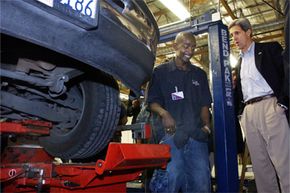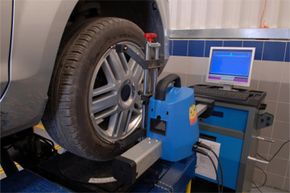If you're wondering whether your car needs an alignment, first look at your tires. Uneven tire wear — often, more wear on the outside of some tires — is a prime indicator that your car is likely out of alignment. Here are a few more indicators:
- Your car seems to be drifting to one side, even when you think you're driving straight.
- Your steering wheel vibrates.
- You are driving straight, but your steering wheel isn't centered.
If none of these indicators occurs but it's been a while since your last alignment, check your owner's manual to see how often the manufacturer recommends having this service.
Advertisement
An out-of-alignment car is a common result of everyday driving. But the term alignment doesn't really refer to your car's wheels, but rather to the suspension. As part of normal driving, parts of your car's suspension may become worn, and springs can be stretched out. Even a small accident or bumping a curb can disrupt your suspension, knocking some of the highly-calibrated components off-kilter, and making your wheels sit at improper angles. An alignment restores these angles to their correct measurements, making sure that your wheels sit straight.
The most visible benefit of an alignment is less tire wear. And when tires do wear down, they'll do so evenly on a properly aligned suspension. Tires can be quite expensive — easily $100 or more per tire — whereas an alignment often costs $50 to $150, making it a cost-effective procedure that should be part of regular car maintenance [source: Consumer Reports].
An alignment will ensure that your car drives straight and handles properly, making your ride safer. You'll also get better gas mileage because your tires will be properly aligned with the road, decreasing resistance.
On the next page, we'll look at what happens during an alignment.
Advertisement




